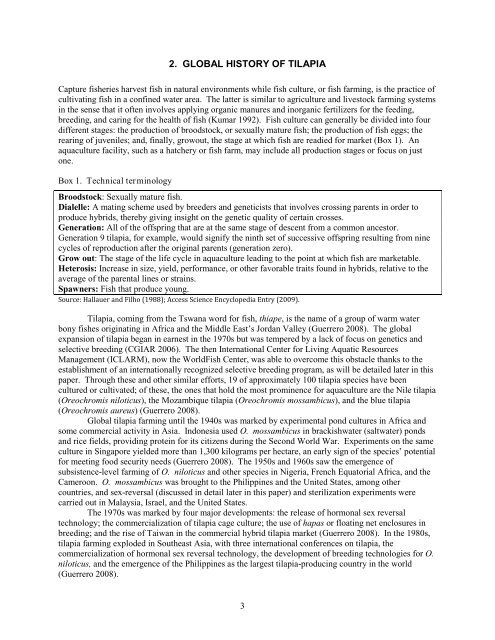Rich Food for Poor People - International Food Policy Research ...
Rich Food for Poor People - International Food Policy Research ...
Rich Food for Poor People - International Food Policy Research ...
Create successful ePaper yourself
Turn your PDF publications into a flip-book with our unique Google optimized e-Paper software.
2. GLOBAL HISTORY OF TILAPIA<br />
Capture fisheries harvest fish in natural environments while fish culture, or fish farming, is the practice of<br />
cultivating fish in a confined water area. The latter is similar to agriculture and livestock farming systems<br />
in the sense that it often involves applying organic manures and inorganic fertilizers <strong>for</strong> the feeding,<br />
breeding, and caring <strong>for</strong> the health of fish (Kumar 1992). Fish culture can generally be divided into four<br />
different stages: the production of broodstock, or sexually mature fish; the production of fish eggs; the<br />
rearing of juveniles; and, finally, growout, the stage at which fish are readied <strong>for</strong> market (Box 1). An<br />
aquaculture facility, such as a hatchery or fish farm, may include all production stages or focus on just<br />
one.<br />
Box 1. Technical terminology<br />
Broodstock: Sexually mature fish.<br />
Dialelle: A mating scheme used by breeders and geneticists that involves crossing parents in order to<br />
produce hybrids, thereby giving insight on the genetic quality of certain crosses.<br />
Generation: All of the offspring that are at the same stage of descent from a common ancestor.<br />
Generation 9 tilapia, <strong>for</strong> example, would signify the ninth set of successive offspring resulting from nine<br />
cycles of reproduction after the original parents (generation zero).<br />
Grow out: The stage of the life cycle in aquaculture leading to the point at which fish are marketable.<br />
Heterosis: Increase in size, yield, per<strong>for</strong>mance, or other favorable traits found in hybrids, relative to the<br />
average of the parental lines or strains.<br />
Spawners: Fish that produce young.<br />
Source: Hallauer and Filho (1988); Access Science Encyclopedia Entry (2009).<br />
Tilapia, coming from the Tswana word <strong>for</strong> fish, thiape, is the name of a group of warm water<br />
bony fishes originating in Africa and the Middle East’s Jordan Valley (Guerrero 2008). The global<br />
expansion of tilapia began in earnest in the 1970s but was tempered by a lack of focus on genetics and<br />
selective breeding (CGIAR 2006). The then <strong>International</strong> Center <strong>for</strong> Living Aquatic Resources<br />
Management (ICLARM), now the WorldFish Center, was able to overcome this obstacle thanks to the<br />
establishment of an internationally recognized selective breeding program, as will be detailed later in this<br />
paper. Through these and other similar ef<strong>for</strong>ts, 19 of approximately 100 tilapia species have been<br />
cultured or cultivated; of these, the ones that hold the most prominence <strong>for</strong> aquaculture are the Nile tilapia<br />
(Oreochromis niloticus), the Mozambique tilapia (Oreochromis mossambicus), and the blue tilapia<br />
(Oreochromis aureus) (Guerrero 2008).<br />
Global tilapia farming until the 1940s was marked by experimental pond cultures in Africa and<br />
some commercial activity in Asia. Indonesia used O. mossambicus in brackishwater (saltwater) ponds<br />
and rice fields, providing protein <strong>for</strong> its citizens during the Second World War. Experiments on the same<br />
culture in Singapore yielded more than 1,300 kilograms per hectare, an early sign of the species’ potential<br />
<strong>for</strong> meeting food security needs (Guerrero 2008). The 1950s and 1960s saw the emergence of<br />
subsistence-level farming of O. niloticus and other species in Nigeria, French Equatorial Africa, and the<br />
Cameroon. O. mossambicus was brought to the Philippines and the United States, among other<br />
countries, and sex-reversal (discussed in detail later in this paper) and sterilization experiments were<br />
carried out in Malaysia, Israel, and the United States.<br />
The 1970s was marked by four major developments: the release of hormonal sex reversal<br />
technology; the commercialization of tilapia cage culture; the use of hapas or floating net enclosures in<br />
breeding; and the rise of Taiwan in the commercial hybrid tilapia market (Guerrero 2008). In the 1980s,<br />
tilapia farming exploded in Southeast Asia, with three international conferences on tilapia, the<br />
commercialization of hormonal sex reversal technology, the development of breeding technologies <strong>for</strong> O.<br />
niloticus, and the emergence of the Philippines as the largest tilapia-producing country in the world<br />
(Guerrero 2008).<br />
3

















